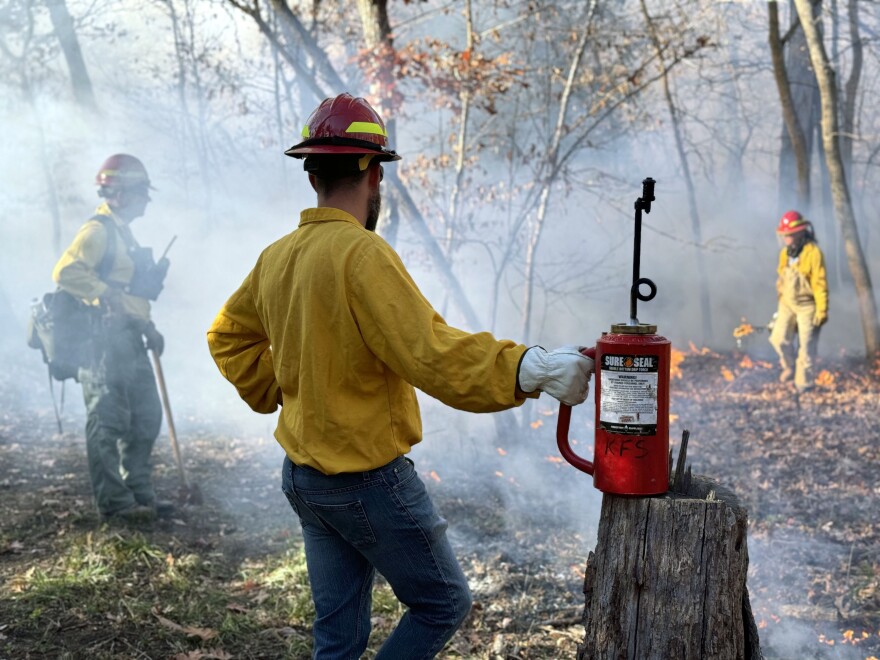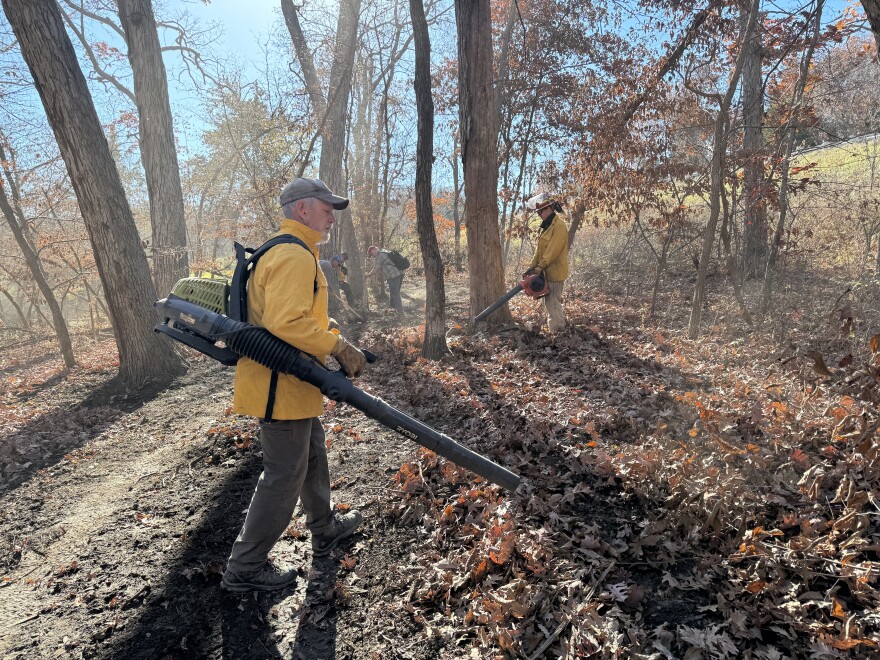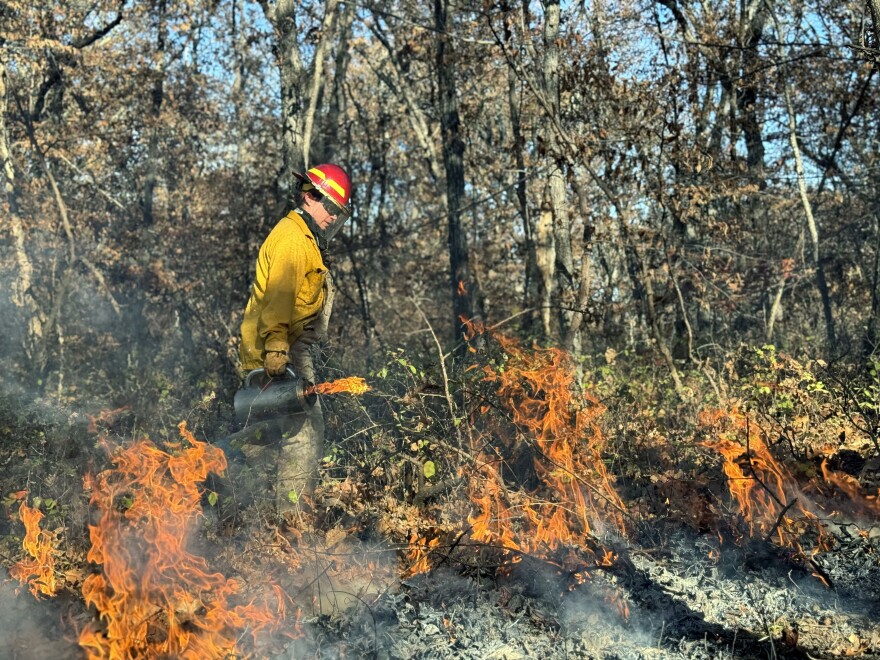DOUGLAS COUNTY – In the Baldwin Woods Forest Preserve south of Lawrence, stately oaks and hickories rise 50 to 100 feet into the air.
But far below their canopy, something worries scientists. Other kinds of trees are gradually elbowing out the next generations of this woodland’s iconic species.
As they do so, they cast more shade to cement their own position.
As the understory darkens, oak and hickory saplings struggle. So do many wildflowers. And, ultimately, so will the pollinators and other creatures that depend on those plants.
But on Nov. 14, about three dozen scientists, foresters and firefighters worked together to bring back a missing ingredient to nearly 40 acres of these woods: flames.
“It’s been a long time coming,” University of Kansas Field Station manager Sheena Parsons said. “It’s a pretty big step.”
After five years of planning, the controlled burn went smoothly.
That sets the stage for burning this section of forest floor every half-decade or so, and eventually burning other sections of the preserve. It also builds local expertise in a region where more people have experience burning prairies than forests.

Parsons hopes this will inspire more landowners to learn how to use fire to keep woodland habitat and wildlife healthy — and even to protect against the growing risk of catastrophic wildfires.
“You can use fire safely,” she said. “It’s not just some scary thing.”
A changing woodland
A similar story is playing out across eastern North America’s ancient oak-hickory forests. One of the continent’s key ecosystems needs help.
Acorns and hickory nuts still shower the ground each fall. But without periodic blazes in the understory, success proves ever harder for these seeds.
Faster-growing species once kept in check by flames shoot up above young oaks and hickories and shade them out.
In much of the eastern U.S., oak-hickory canopies are morphing into maple forests mixed with beeches, birches, poplars or other companions.
In eastern Kansas — the westernmost edge of the continent’s oak-hickory biome — other species are leading a similar transition. These include hackberries, redbuds, ashes, elms, hop hornbeams and junipers.
As oak-hickory canopies wane across the eastern U.S., biodiversity can take a hit or shift in ways that break the links between insects, their host plants and the rest of the food web.

Meanwhile, other changes happen on the forest floor, where periodic fires once left their mark on soil nutrients, leaf litter accumulation and more.
Scientists are still documenting the implications, which appear significant. The National Park Service says the shift to maple forests, for example, can mean losing a third of the diversity among the wildflowers and other soft plants that grow low to the ground. Oak canopies also support more kinds of birds and insects.
In the Baldwin Woods Forest Preserve, coralberry thickets have spread far and wide over the years, while the blooms of Michigan lilies became a rarer sight.
“They never flower, because they don’t get enough sun,” said Bill Busby, a retired zoology professor and emeritus director of the preserve.
KU scientists believe periodic fire could also help the wide variety of early springtime flowers that characterize healthy oak-hickory woods.
They hope it will shrink the oversized footprint of species such as coralberry.
“We’re not trying to get rid of it,” Busby said. “We just want balance.”
Native Americans and fire
Rice Woodland, where the Nov. 14 controlled fire took place, is part of the 460-acre Baldwin Woods Forest Preserve managed by the Kansas Biological Survey & Center for Ecological Research.

Parts of the area never fell to clear-cutting. It’s a rare stretch of relatively undisturbed, mature oak-hickory habitat with centuries of history, if not millennia. The increasing scarcity of such places led to the Baldwin Woods region becoming a national natural landmark.
It’s unclear how many decades have passed since fire last swept the understory of the preserve.
In the 1800s and earlier, Native Americans set fires here as they did in many forests, woods, savannas and prairies across North America.
Oaks, in particular, have bark and root systems that excel at surviving fire.
So in oak-hickory habitats, fires maintained relatively open canopies that allowed forest floors rich in hunting opportunities and full of diverse plants for food and medicine.
After the U.S. government and settlers pressed, swindled and forcibly removed Native Americans from their lands, they gradually eliminated fire, too.
Later, generations of Americans grew up with Smokey Bear’s motto, “Only you can prevent forest fires.”
Policies that suppressed fire across the board actually contributed to forests becoming more prone to intensely destructive, out-of-control blazes.

Even prairies starved of fire have become clogged with brush and trees that can make blazes more dangerous, exacerbating an increase in major wildfires on the Great Plains.
In 2001, Smokey Bear’s motto changed to “Only you can prevent wildfires.” The subtle difference recognizes that prescribed fire isn’t wildfire — and that it plays key roles in habitat resilience.
A low and slow fire
Luke Berning’s job at the Kansas Forest Service focuses on preventing fires — the bad kind. Often that means helping with the good kind.
So on the morning of Nov. 14, he cheerily hauled equipment into Rice Woodland with the goal of helping its oaks and hickories.
“I’m excited,” he said, and gestured to the tallest trees in front of him. “In 60, 70, 120 years, when these oaks have aged out, there (will be) stock to replace them.”
Oak-hickory habitats feed and house a spectacular array of wildlife, including legions of moths, butterflies, weevils, ants and spiders that underpin the food web.
Their nutrition-packed nuts offer protein, fat and minerals each fall as winter approaches. Deer, turkeys, quail, nuthatches, wood ducks and other creatures flock to this buffet.
The shagbark hickories common in Baldwin Woods have distinctive curls of peeling bark that create little awnings for bats and other critters to call home.
Flying squirrels, a species that the Kansas wildlife department has listed as needing conservation, live in these woods.
Setting fire to the forest floor required waiting for just the right weather. Neither too wet or humid nor too dry. Crews needed wind that wasn’t too strong or blowing from the wrong direction.

Plans were canceled multiple times before the weather finally cooperated.
Then teams fanned out to finish work they had started well in advance: clearing 8-foot-wide paths down to bare soil to contain the flames to 39 acres.
Next they paced through the woods, using specialized torches to light the leaf litter every several feet.
“We don’t want any of our flame lengths to get above three feet,” forester E.J. Jamison explained. “So it’s just going to do a nice creep across the forest floor in the direction that we intend.”
The fire behaved just as hoped. The results, though, will take months, even years to observe.
Jamison hoped the low-to-the-ground blaze would bring enough heat to weaken some of the young hop hornbeams she saw all around her.
“Right here we have a bunch of little oak seedlings,” she said, pointing downward to 1-foot-tall chinkapins near her feet — underdogs poking up through a thick layer of leaf litter. “We’re hoping that those respond really well.”
Celia Llopis-Jepsen is the environment reporter for the Kansas News Service. You can follow her on Twitter @celia_LJ or email her at celia (at) kcur (dot) org.
The Kansas News Service is a collaboration of KCUR, Kansas Public Radio, KMUW and High Plains Public Radio focused on health, the social determinants of health and their connection to public policy.
Kansas News Service stories and photos may be republished by news media at no cost with proper attribution and a link to ksnewsservice.org.





